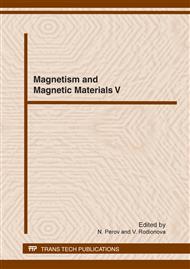[1]
A. Leonhardt, M. Ritschel, R. Kozhuharova, A. Graff, T. Mühl, R. Huhle, I. Mönch, D. Elefant, C.M. Schneider, Synthesis and properties of filled carbon nanotubes, Diamond Relat. Mater. 12 (2003) 790-793.
DOI: 10.1016/s0925-9635(02)00325-4
Google Scholar
[2]
R.F. Egerton, Electron Energy-loss spectroscopy in the Electron Microscopy, second ed., Plenum Press, New York, (1996).
Google Scholar
[3]
F. Wang, M. Malac, and R.F. Egerton, Energy-loss near-edge fine structure of iron nanoparticles, Micron, 37 (2006) 316-323.
DOI: 10.1016/j.micron.2005.12.003
Google Scholar
[4]
C. Colliex, T. Manoubi, C. Ortiz, Electron-energy-loss-spectroscopy near-edge fine structures in the iron-oxygen system, Phys. Rev. B 44 (1991) 11402-11411.
DOI: 10.1103/physrevb.44.11402
Google Scholar
[5]
S. Muto, T. Kimura, T. Tanabe, T. Kiyobayashi, T. Maruyama, Transmission electron microscopy and electron energy-loss spectroscopy analysis of hydrogenated nanostructured graphite prepared by mechanical milling, Jpn. J. Appl. Phys. 44 (2005).
DOI: 10.1143/jjap.44.2061
Google Scholar
[6]
Information on http: /www. nanofactory. com.
Google Scholar
[7]
K. Mølhave, S.B. Gudnason, A.T. Pedersen C.H. Clausen, A. Horsewell, P. Bøggild, Transmission electron microscopy study of individual carbon nanotube breakdown caused by Joule heating in air, Nano Lett. 6 (2006) 1663-1668.
DOI: 10.1021/nl060821n
Google Scholar
[8]
F. Zhou, L. Lu, D.L. Zhang, Z.W. Pan, S.S. Xie, Linear conductance of multiwalled carbon nanotubes at high temperatures, Solid State Commun. 129 (2004) 407-410.
DOI: 10.1016/j.ssc.2003.09.040
Google Scholar
[9]
T.Y. Choi, D. Poulikakos, J. Tharian, U. Sennhauser, Measurement of thermal conductivity of individual multiwalled carbon nanotubes by the 3-ω method, Appl. Phys. Lett. 87 (2005) 013108.
DOI: 10.1063/1.1957118
Google Scholar
[10]
T.D. Yuzvinsky, W. Mickelson, S Aloni, S.L. Konsek, A.M. Fennimore, G.E. Begtrup, A. Kis, B.C. Regan, A. Zettl, Imaging the life story of nanotube devices, Appl. Phy. Lett. 87 (2005) 083103.
DOI: 10.1063/1.2012529
Google Scholar
[11]
M. Hupalo, S Binz, M.C. Tringides, Strong metal adatom-substrate interaction of Gd and Fe with graphene, J. Phys.: Condens. Matter, 23 (2011) 045005.
DOI: 10.1088/0953-8984/23/4/045005
Google Scholar


